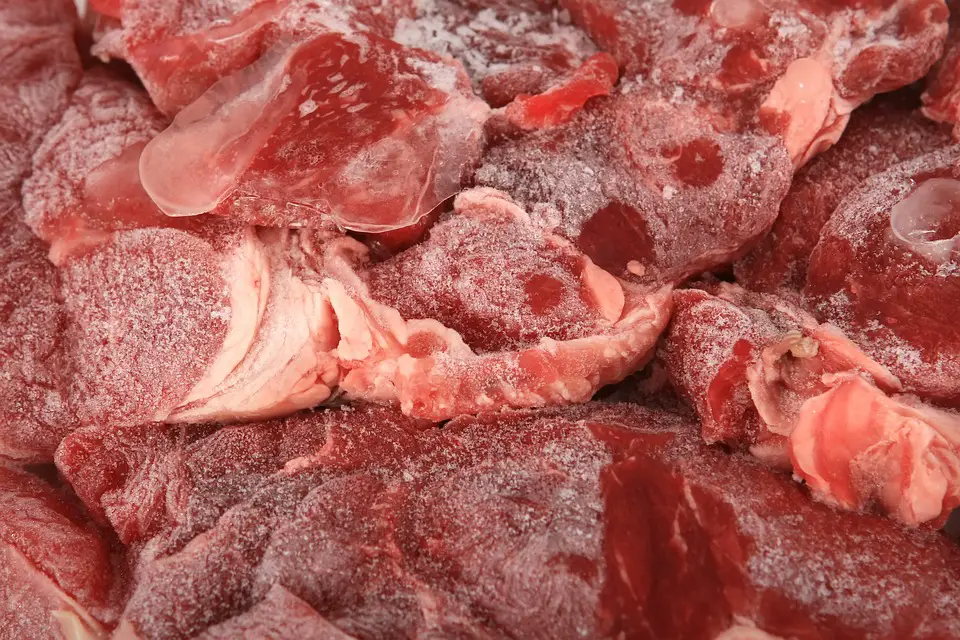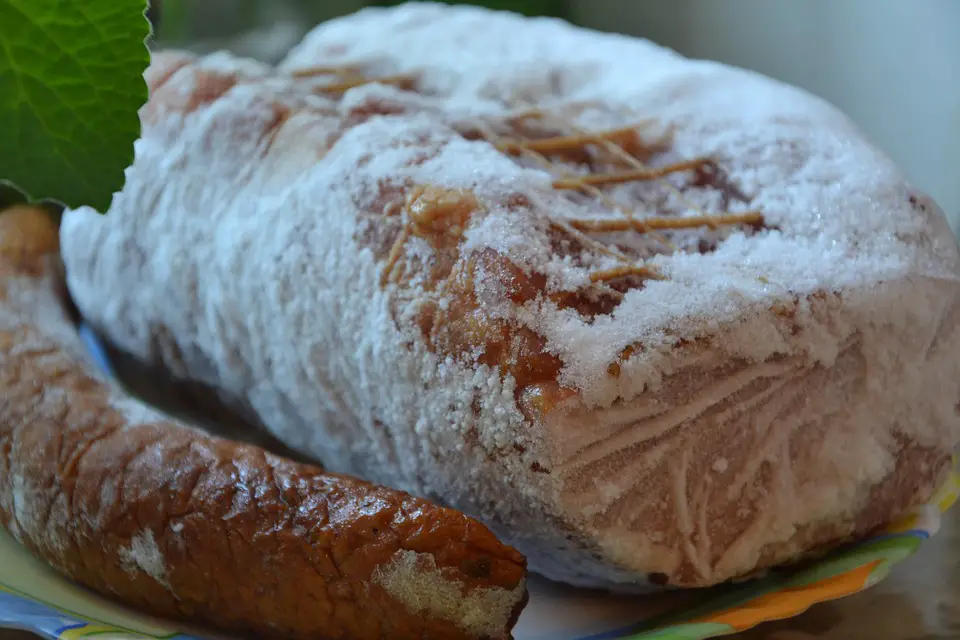The safest approach to defrost meat is in the refrigerator overnight, albeit it isn’t the fastest. The frozen beef will defrost overnight safely and gradually if kept at a temperature of 40°F or lower (4.4°C). Whether the meat is vacuum-packed, we always advise defrosting it in a bowl. Reason: As the water molecules transition from a frozen to a liquid state during defrosting, frozen meat will somewhat lose mass.
A study published by the New York Times reports that thawing frozen meat in warm water can be dangerous. This study shows that bacteria can multiply faster when the surface of the meat is exposed to warm water. This is because bacteria multiply in the danger zone at a rate of double every 20 minutes.

What is a Meat?
Animal muscle makes up the majority of meat. Most animal muscle comprises about 75% water, 20% protein, and 5% fat, carbs, and other proteins. The fibers that make up muscles are collections of cells.
Actin and myosin, two proteins, are crowded into every cell to form filaments.
These protein filaments cause muscles to contract and relax in a living animal. Both tasks demand tremendous energy from the ATP energy-carrying molecule (adenosine triphosphate). The most effective ATP synthesis requires oxygen, which muscles obtain from the blood flowing through them.
How Long does it Take to Defrost Meat?
Steaks, ground beef, and stew meat can defy in the fridge in under a day. Whole roasts and pieces with bones may require two days or more. The uncooked ground beef can be kept in the fridge for one to two days after it has been thawed. Before cooking, all other beef cuts can be securely stored in the refrigerator for 3 to 5 days.
If you decide not to utilize the beef during this time, you can safely refreeze it without cooking. Three safe methods of thawing beef are the refrigerator, cold water, and microwave. Never defrost food on the counter or anywhere else. It’s better to prepare in advance for a slow, secure defrosting in the fridge.
Don’t take the package off when defrosting beef in cold water. Please ensure the container is sealed, or place it in a bag that won’t leak. The beef should be submerged in cold water, changing it every 30 minutes so it can continue to defrost. A 3- to 4-pound roast may take 2 to 3 hours to thaw; smaller packages of beef may do so in an hour or less. Cook right away. Consult your microwave’s owner’s manual for instructions on microwave-thaw frozen food. After thawing, prepare to cook it right away because some parts of the meal may get warm during microwaving and start to cook.
What are the Different Ways of Defrosting Meat?
Room Temperature Method
Room temperatures typically vary from 68 to 77 degrees Fahrenheit, within the danger zone range of temperatures where the growth of hazardous bacteria is most likely to occur. As a result, you should frequently check the defrosting meat’s temperature. When the meat reaches a temperature of about 40 degrees Fahrenheit, transfer it to the refrigerator and continue the defrosting process there.
Pounding Method
The lease takes off the ground beef block from its package, sandwich it between two sheets of parchment paper, or places it in a plastic bag. Place the meat on a countertop or cutting board. Pound the meat into a thinner square or rectangle with a rolling pin. The meat will defrost more quickly if it is pounded thinner. This procedure may be effective when you need to finish the task fast, and the meat has just about completely thawed—or at least the exterior layer has.
Method Using a Microwave
Thaw frozen meat in a microwave oven on the defrost setting for a quick weekday meal. The meal should be defrosted in the microwave rapidly enough that dangerous bacteria won’t be able to develop on the meat while it’s in the danger zone. If the meat pieces are uneven or of different sizes, some will defrost or cook before others when thawing in the microwave.
What are the Things that Must be Considered While Buying Frozen Meat?
Frozen in Blaze
Make sure the brand you purchase employs blast freezing techniques rather than conventional freezing. Blasting freezing protects the meat’s molecular structure by preventing freezer burn, which dries up meat.
Thawing Indicators
This is safe and acceptable if it appears slightly defrosted. Ensure it is chilly to the touch or at least 40 °F/4.4 °C. Use it right away or immediately refreeze it when you get home.
Standard
Verify that the meat is not discolored or otherwise compromised.
Vacuum Packaged
Try to purchase frozen meat if possible instead of frozen meat. When sealed, vacuum packaging removes 98% of the air from the container, further protecting it from microorganisms and extending its shelf life in your home freezer by many months. Meat vacuum-packed for storage also makes defrosting simple.
Packaging without BPA
Consider purchasing BPA-free packaging. Research on this topic has produced inconsistent results. The FDA has publicly indicated that the small amounts of BPA in food do not pose a threat.
How to Preserve Meat for Longer Duration?
Before freezing, prepare the meat. Prepare and package the meat before freezing it to avoid freezer burn.
Meat and poultry can be frozen in their original store packaging, but it’s best to overwrap them to prevent air from getting inside. Use plastic bags and sturdy aluminum foil specifically created for freezers.
To remove air from packaging, use a vacuum sealer at home. Vacuum sealers employ specialized bags (available separately) to store food and come in various styles and costs.
Use airtight cans and jars that can be frozen, such as plastic containers.
Use wrapping materials like polyethylene wrap and bags, heavy-duty aluminum foil, and plastic freezer bags.
Before freezing, remove as many bones as possible because they take up room and can cause a burn to the freezer.
To make separation after freezing simpler, place freezer paper or wrap it between beef patties or slices.
What are the Different Methods of Cooking Meat?
Braise: Braising is a cooking method in which the meat is cooked in a heavy pan and browned on all sides. The meat is cooked at a low temperature until soft after adding a small amount of water.
Broil – Broiling is done on an outdoor grill or in an oven. The meat should be cooked until browned on one side. Then broil the other side until it is done how you like it.
Cooking in liquid – Less tender portions of meat are frequently prepared by cooking in liquid. Due to the lower temperatures, the process can take many hours. The meat is cooked until soft and covered in liquid (often water).
Broiling food on a pan is comparable to broiling food in an oven, but it’s quicker and easier. The meat is cooked in a nonstick pan, occasionally rotating until it is well-browned on both sides. There is no requirement to cover the meat or add water.
Pan Fry: The only way panfrying differs from pan broiling is by adding a tiny amount of fat in the beginning. Meat that has been crushed or cut into thin pieces is pan-fried.
How to Tell Meat has Gone Bad?
Inhale it
Rely on your nose to detect rotten meat. The simplest way to determine whether meat has gone bad is to smell it. No matter what kind of meat it is, it should not be consumed if it smells foul and rotting. The minced meat must smell fresh, whether purchasing it from a grocery store or getting takeout. The first step in preparing a nutritious dinner is to smell the meat since it may initially appear fresh, but that does not necessarily mean it is. When smelling the meat, it would be best to look for a strong, unpleasant smell.
Look at the Texture of it.
Is the flesh greasy to the touch? If it does, it might not be safe to eat. Typically, poor meat feels sticky to the touch. Slimy meat indicates the presence of bacteria that have begun to grow on its surface. You might observe the emergence of black or green spots due to bacteria, which indicates that fungi have begun to increase.
Examine its Color
Take a moment to examine the meat more closely. Most people picture fresh minced beef as brilliant red. The meat hasn’t necessarily gone bad if it has turned brown or dark grey. Said it indicates that the meat isn’t getting any oxygen. Even though ground beef isn’t always an attractive bright red, grocery stores and restaurants continue to sell it that way because it draws customers’ attention. It’s vital to remember that brown to grey meat is OK to consume, but if it becomes dull and green, it should be thrown out.
What will happen if you Consume Bad Meat?
A wide variety of bacteria can cause meat spoilage. Bacterial contamination can originate from the animal (often from the intestines) or people, particularly if they didn’t wash their hands before handling food. Additionally, filthy kitchen equipment has the potential to harbor microorganisms.
You are more prone to become ill from pathogenic germs, including E. coli, salmonella, and staphylococcus. According to the Mayo Clinic, you can become ill from some of these germs even if you only eat a small bit.
It is known that specific pathogenic bacterial strains can produce bloody diarrhea. You’ll probably get food poisoning if you consume meat tainted with these microorganisms. According to the Mayo Clinic, food poisoning symptoms include nausea, vomiting, fever, abdominal discomfort, and other gastrointestinal problems. Food poisoning may persist for a few hours or several days.
Conclusion
Leaving meat out to thaw at room temperature is not a safe practice. This process could cause the meat to become contaminated with bacteria, one of the most common causes of foodborne illness. It should not be left out for more than two hours.
The temperature at which meat thaws in the freezer will vary, depending on the type of meat. Larger pieces of meat will take longer to thaw than smaller ones. You can also thaw your meat in a bowl of lukewarm water. You should change the water every 30 minutes to ensure that the outside is not heated to a higher temperature than the inside.
